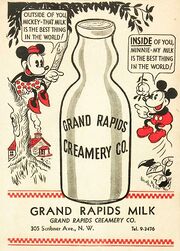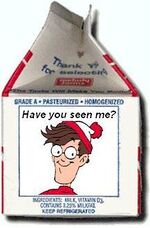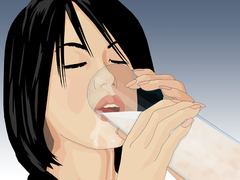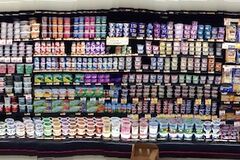Lactose
Lactose (or milk sugar) is the chemical that makes milk sweet. It is a sugar, but it is not sugar, see? Humans and mammals can digest it, or all babies would starve despite getting all the milk they want. At some point in development, the individual stops being able to digest it. This is just one of nature's little hints to break free of the tit and fend for yourself in the wild. At a relatively recent point in the past, humans remarkably started to be able to digest lactose into adulthood. At about the same time, humans developed a lifelong obsession with breasts.
Chemistry
Lactose is a long sugar found in milk. Not as long as Stevia, but pretty long. During digestion, lactose is attacked by an enzyme called lactase, so-named to avoid confusion. Lactase breaks lactose down into sucrose (the real thing), and also Galactus and the Silver Surfer. These smaller pieces can then enter the bloodstream, presumably thanks to the Silver Surfer's "power cosmic."
This process magical occurs in the intestine small, just past the stomach. Just as magical, except to the stomach's owner, is what happens when this process doesn't occur. Lactose is irresistible to certain intestinal bacteria that scientists delicately describe as "gut flora" as though there were an arboretum down there. Gut flora flock to lactose faster than dogs attacking anything that falls off the Christmas table. However, the flora have even fewer table manners than dogs have. They don't use napkins, don't excuse themselves, and produce noxious by-products, including irritating acids and scads of gas.
About an hour after the human or mammal has congratulated the hostess for a tasty meal, he becomes aware that his body is full of compounds that would work much better being anywhere else. As the above process occurs past the stomach, it is too late for them to come back up, so they are going to go down. Fast. The rest is history.
The chemical reaction is shown in the following equation:
Biology

Remarkably, some modern humans remain able to break down lactose, faster than gut flora can get to it, for their entire lives. Even more remarkably, scientists have DNA from prehistoric humans (see Jurassic Park) and can see that the definition of human being has changed in under ten millennia. This, after all, is not the invention of some new process; it is simply DNA copying itself imperfectly, as DNA often does. (See Jimmy Savile.) Your toddler proves it is far easier to break things than build new things; and this mutation breaks an existing process — namely, the process that itself broke the process of digestion of lactose, when it is time for the individual to get weaned off its mother's breast.
Science then addressed causation. This is never a topic of science — as researchers can neither turn the clock back to see what would have happened otherwise nor ask God what the hell He was thinking. (Actually, scientists can, but He tends not to tell them.)
Happily, compared to the scientific consensus on global warming (in which everything is Donald Trump's fault), scientists have entertained two competing theories of why this evolution occurred:
- We adapted. The adaptation theory holds that, in societies that adopted dairy farming, the mutation was advantageous toward producing more offspring. Clearly, during courtship, individuals who neither had to keep running to the bathroom nor failed to get there in time, would win their partner's hearts by ceasing to lose their noses.
- We got adapted. The reverse adaptation theory holds that, when certain individuals became able to tolerate this noxious sugar for their entire lives, dairy farming suddenly became feasible.
There is no way to decide between these theories of causation, as there is no grant money to imprison thousands of people, mutate their genes, and see if they start trying to buy cows.
The camps are agreed on several things:
- The mutation did not happen everywhere on Earth. Scientists can see six sites where the genome broke, letting the bearer keep drinking milk. They have long numbers to describe these defects, though they have never repaired them to see if the bearer resumes having more gas than a truck stop. They even say one of the breakages occurred in two different places on earth that had nothing to do with one another.
- In fact, the mutation correlates strongly with societies that have dairies. Virtually all the Irish have the mutation, and most Greeks do not, as they merely have news-stands and sidewalk cafés. Nearly no Africans have it, as you know if you've been around one of them after a jaunt to Burger King.
- Drinking milk all your life confers a survival benefit.
- Milk does not give you diseases like malaria (provided you keep it in the fridge), as the cow had the first chance to get it and presumably did not.
- Milk contains calcium — as competing drinks in prehistoric societies didn't — which is good for you.
- Going into the barn and sucking on a cow's teat every day is a much safer lifestyle than hunting wooly mammoths or venturing far from camp to bring back things that might be edible.
- Keeping a dairy lets you stay in one place permanently, rather than pick up camp and move somewhere else entirely when the food runs out.
Marketing
Currently, about half the world's population has broken DNA and can enjoy milk into adulthood. If the two halves of humankind set against each another for dominance, it would be a cataclysm, though neither half has hypersonic missiles, nor any weapon that acts faster than lactose itself. In the Old World, each country has its own mutation level and its own supermarkets. However, in the American "melting pot" where no one really knows who his father is, supermarkets contain customers with DNA from anywhere, and it is every shopper for himself.
The modern supermarket has many products that let you pretend you are consuming lactose when you are not. There are dozens of varieties of milk, depending on what you want not to be in it. They are all competitively priced, given that dairy farmers now spend more money lobbying than farming, to get laws passed that none of them can be called milk.
The easiest way to make a "lactose-free" product is not to take out the lactose at all, but to pump in lactase, so that the troublesome part of digestion occurs not in the stomach or gut but in the milk carton.
However, there are just as many products that are not supposed to contain lactose but do, thanks to additives such as whey. After all, when you take lactose out, it has to go somewhere, and that is never the wastebasket but somewhere else in the shopping cart. Diners continue to experience the horrors that made so many people's DNA snap apart in the first place; only now, they never know exactly what hit them.
However, there is no product defect so severe that the businessman can't respond by selling you something else in addition. Consequently, the supermarket now has convenient, chewable tablets that will give you, for an hour or so, the lactase that God would not.
See also
| Featured version: 02 February 2022 | |
| This article has been featured on the main page. — You can vote for or nominate your favourite articles at Uncyclopedia:VFH. | |





